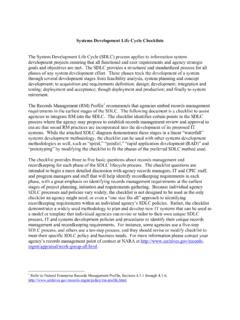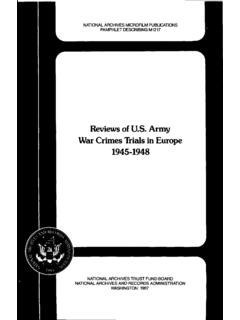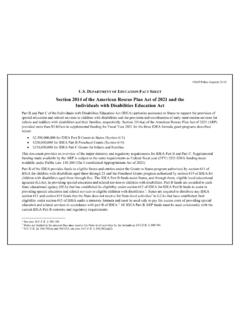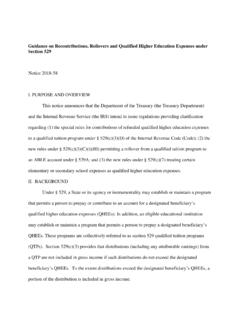Transcription of Overview: The Farm Security Administration - Archives
1 Overview: The farm Security Administration For those born after the 1930s, the Great Depression is something that can be visualized only through photography and film. Certain images have come to define our view of that uncertain time: an anxious migrant mother with her three small children; a fanner and his sons struggling through a dust storm; a family of sharecroppers gathered outside their spartan home. These photographs are icons of an era. Remarkably, many of these familiar images were created by one small government agency established by Franklin Roosevelt: the farm Security Administration (FSA). Between 1935 and 1943, FSA photographers produced nearly eighty thousand pictures of life in Depression-era America. This remains the largest documentary photography project of a people ever undertaken. President Roosevelt created the farm Security Administration (FSA) in 1937 to aid poor farmers, sharecroppers, tenant fanners and migrant workers. It developed out of an earlier New Deal agency called the Resettlement Administration (RA).
2 The FSA resettled poor farmers on more productive land, promoted soil conservation, provided emergency relief and loaned money to help fanners buy and improve farms. It built experimental rural communities, suburban "Greenbelt towns" and sanitary camps for migrant farm workers. One of the New Deal's most progressive-and controversial-agencies, the farm Security Administration (FSA) advocated government planning and economic intervention to improve living conditions in rural America. Conservative critics attacked the FSA and its predecessor, the Resettlement Administration (RA). as "socialistic." To defend and promote the Resettlement Administration director Rexford Tugwell created a publicity department to document rural poverty and government efforts to alleviate it. It included a photographic unit with an odd name-the "Historical section " In 1937. the RA and its Historical section were merged into the newly created FSA. Tugwell chose Roy Stryker, a college economics instructor, to run the Historical section .
3 Though not a photographer, Stryker successfully directed an extraordinary group of men and women who today comprise a virtual "Who's Who" of twentieth century documentary photography. Many later forged careers that helped define photojournalism at magazines like Life and Look. The FSA photographic unit was not a "jobs program" like the New Deal's Federal Arts Project. Photographers were hired solely for their skills. Most were in their twenties or thirties. They traveled the nation on assignments that could last for months. snar ndrtheSearingun--------, .LEFTABOYE:B ONEwhiteningatthound- ofn-parchedwater holelikehiatPennington, ,symbolizether100mthatho0ertheplaincounr yIondenieoOnParchedPlainsTheGreatPlainsa ndtheSouthwestThemostenduringimageofrura lAmericaduringtheGreatDepressionis formedinthenation'sheartland, , depletedtopsoilinenormous"dust storms." Dramaticandfrightening, , Kansas,Colorado,NewMexicoandtheTexasPanh andle-wasnicknamedthe"Dust Bowl.
4 "FSAphotographersrecordedthehardshipstha tdrought, Themigrantflowoutoftheregionincludedpeop lefromcitiesandsmalltownsandfarmlaborers who' , Californiarepresentedhope. Duringthe1910sand1920s, somebegantravelingtoCaliforniaandotherFa rWesternstatesinsearchofwork. WhentheDepressionhit, newsofjobspickingcropsonthestate's , dubbed"Oakies"or"Arkies," "ditchback camps" , Theybecameislandsofstabilityformigrantse nduringgrindingpovertyanddislocation. InJohnSteinbeck's1939novel,TheGrapes a/Wrath,theloadfamilyspendstimeina rhundredofhu<cropp<:Thev\tandertherutted road""":'noshelter,norelief, inrentsandoldU!Xl<.TheFuture ?TheSouthLongbeforetheGreatDepression, ,it (or, forsharecroppers,a portionofthecrop), , lifefortheseworkerswasharsh, ,ironically, , 'slargeAfricanAmericanpopulationcarriedt heheaviestburden. ,discrimination, ' s Northeast and Midwest The FSA photography unit is best known for its images of rural life in the South, the Great Plains and the West.
5 But in thousands of images FSA photographers also created a vivid record of life in the farms, towns, and cities of the Northeast and Midwest. Agency photographers documented mining towns in Pennsylvania, slum housing in Chicago and Washington and rural life in Ohio, New England, and upstate New York. They studied the lives of migrant farm workers in Michigan and the homes of packinghouse employees in New Jersey. Their work offers glimpses into everything from unemployment lines and child labor to social life and leisure activities. The Photo Project Goes to War With the outbreak of World War II, the focus of the FSA photo project began to change. As the nation's attention turned from economic and social issues at home to the war against Germany, Italy and Japan, the photo unit reflected this shift. Roy Stryker encouraged his photographers to take more "positive" images of American life to bolster America's war effort. And while FSA photographers continued to document poverty and inequality, they were told to increase their output of photographs featuring reassuring images of American life.
6 Pictures of defense factories, war workers and patriotic activities on the home front also began entering the FSA files. In October 1942 the FSA photo unit became part ofthe new Office of War Information (OWl), created to direct America's wartime propaganda efforts. The following year the unit formally went out of existence. Director Roy Stryker left government and a few FSA photographers went to work for the OWL Saving the FSA Photographs As the FSA photo project neared its end, Director Roy Stryker faced a dilemma. From 1935 to 1943, he had created a vast trove of nearly eighty thousand photographs (and 68,000 unprinted negatives). Stryker recognized the importance of this collection to history and feared it might be dispersed when it came under the full control of the Office of War Information (OWl). A seasoned Washington bureaucrat, Stryker had been maneuvering as early as 1939 to secure a safe harbor for the collection in the Library of Congress.
7 Now, working with his friend Archibald MacLeish --who was both the Librarian of Congress and Assistant Director of the OWI--Stryker helped arrange a transfer of the entire FSA photo file to the Library's custody under unusual terms. The Library took title to the collection in 1944, but loaned it back to the OWl for the duration of the war. In 1946, the collection was physically moved to the Library, where it is available to all for study and reproduction. This curriculum guide draws from that collection and presents a new generation the opportunity to examine the role of photographs as historical evidence. By examining, thinking, and asking questions about photographs, students will learn to better understand how and why they were created and used. Nearly all of the photographs shot by the FSA are black and white. But during the photo unit's later years a few photographers began experimenting with color photography. In some cases, these photographers shot the same subjects in both black and white and color.
8 These photographs are drawn from the 644 color transparencies and 35 mm Kodachrome slides in the FSA photo collection. None of these color images were published during the 1930s and 1940s. The entire group was only discovered at the Library of Congress during the 1970s. These images can seem startling, because we are accustomed to experiencing the 1930s and 1940s in black and white. But color photography draws the viewer into the past in a different way. Color makes the photographs appear more immediate and intimate. Faces in color appear more real--more like us. The effect is often arresting. These are just a few technical and editorial considerations that need to be kept in mind when viewing photographs as historical evidence. The activities that follow will allow your students the opportunity to explore these and other considerations in greater detail. APRILIf,9J1bNt'ltJIOtk~imttJ!t\uga~int ",11.,.11m'",..ti 'nen. ,Seclio















